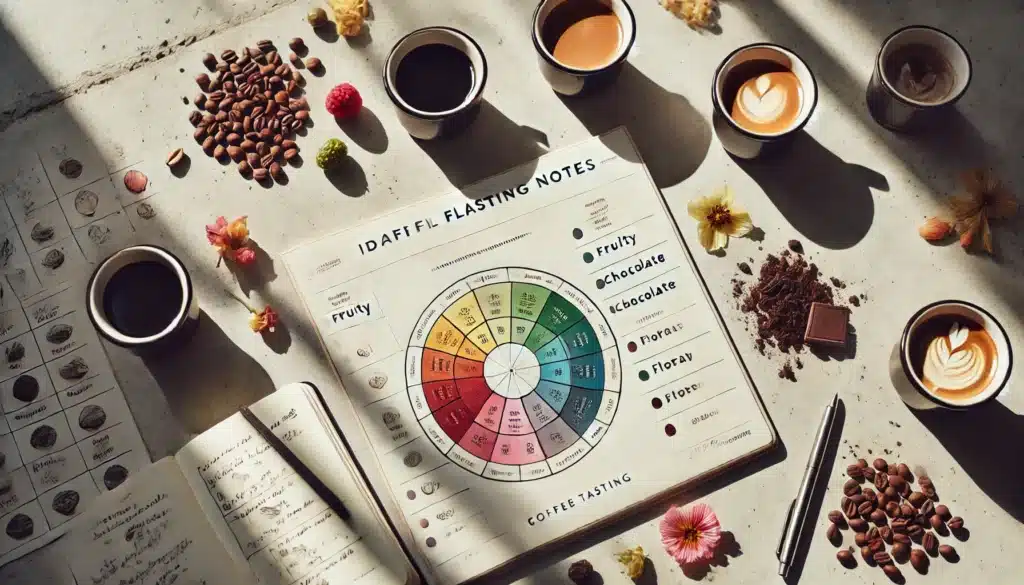Ever tasted a coffee and wondered, “Where’s the blueberry everyone talks about?” Recognizing flavor notes in coffee can seem like magic at first, but with practice and attention, you can learn to identify the subtle (and sometimes bold) flavors that make specialty coffee so exciting.
In this guide, we’ll explore how to train your palate to detect fruity, chocolatey, floral, and other notes in your cup — and how they get there in the first place.
1. What Are Coffee Flavor Notes?
Flavor notes are the natural taste and aroma characteristics found in coffee — they’re not added artificially. They come from:
- The coffee variety
- The soil and climate (terroir)
- The processing method
- The roast profile
- The brewing style
Think of them like the notes in wine or chocolate — complex, layered, and diverse.
2. Start with Your Senses
Use all your senses when tasting coffee:
- Smell the dry grounds (dry aroma)
- Inhale the scent after brewing (wet aroma)
- Slurp the coffee to aerate it
- Pay attention to how it feels and lingers
These steps open the door to recognizing flavors beyond “just coffee.”
3. Learn the Flavor Categories
Flavor wheels — like the SCA Coffee Taster’s Flavor Wheel — divide notes into categories:
- Fruity: citrus, berry, stone fruit, tropical
- Floral: jasmine, rose, lavender
- Nutty/Cocoa: hazelnut, almond, dark chocolate
- Spices: cinnamon, clove, pepper
- Sweet: caramel, honey, brown sugar
- Other: earthy, fermented, savory
Start broad, then narrow in as you taste more.
4. Fruity Notes
Fruity coffees are usually:
- Naturally processed
- From regions like Ethiopia, Kenya, Colombia
- Light to medium roasted
Common fruit notes:
- Citrus: lemon, orange, grapefruit
- Berry: blueberry, raspberry, strawberry
- Tropical: mango, pineapple, papaya
- Apple/Pear: crisp acidity and sweetness
These notes bring brightness and complexity.
5. Chocolatey and Nutty Notes
Chocolate and nut flavors are common in:
- Washed or honey-processed coffees
- Medium roasts
- Origins like Brazil, Guatemala, and Sumatra
Look for:
- Milk chocolate or dark chocolate
- Hazelnut, almond, peanut butter
- Toffee, nougat, or cocoa powder
These notes feel familiar, comforting, and smooth.
6. Floral Notes
Floral flavors are subtle and delicate. You’ll find them in:
- Ethiopian or Panamanian coffees (especially Geisha)
- Washed and lightly roasted beans
- High-altitude, slow-grown varieties
Examples:
- Jasmine or rose: fragrant and tea-like
- Lavender or bergamot: aromatic and refreshing
Floral coffees often have a light body and crisp acidity.
7. Processing Method Matters
The way coffee is processed impacts flavor heavily:
- Natural (dry): fruity, funky, wine-like
- Washed (wet): clean, bright, transparent
- Honey/semi-washed: sweet, balanced, syrupy
Processing affects how sugars, acids, and aromatics develop — and what you taste.
8. Roast Profile and Flavor
Roast level can amplify or mute flavor notes:
- Light roast: preserves fruit, florals, acidity
- Medium roast: enhances sweetness, chocolate, balance
- Dark roast: flattens subtleties, boosts bitterness and body
For flavor note discovery, light to medium roasts are ideal.
9. Practice with Guided Tastings
To improve your palate:
- Join a cupping session at a local roaster
- Use a flavor wheel during tastings
- Compare different origins and processes side by side
- Try coffees with listed notes and try to find them
Tasting is a skill — and repetition is key.
10. Keep a Flavor Journal
Track your impressions with each cup:
- What did you smell before brewing?
- What flavors did you notice first?
- What lingered after?
- How did the roast, brew method, or origin affect it?
Over time, you’ll learn which notes you love — and recognize them more easily.
Final Thoughts: Unlocking the Language of Coffee
Recognizing coffee flavor notes is like learning a new language — and every cup is a conversation. The more you taste, compare, and reflect, the sharper your sensory skills will become.
So take your time, trust your senses, and enjoy the journey from curious sipper to confident taster.







